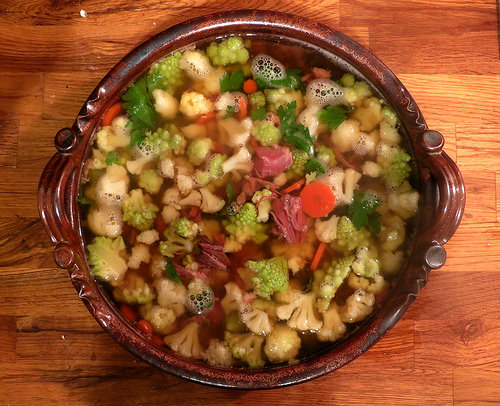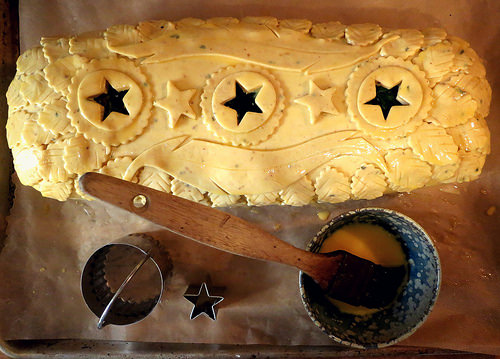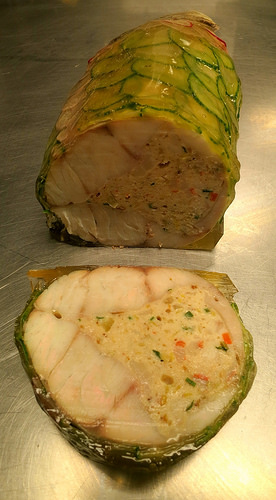-
Posts
270 -
Joined
-
Last visited
Content Type
Profiles
Forums
Store
Help Articles
Posts posted by Baron d'Apcher
-
-
Consider stuffing the breasts, like one would with veal.
Stuffed lamb breast. Lamb liver, heart & tongue, pork fatback, olives and pistachios.
Gently seared and slowly roasted covered, then dutifully basted and glazed uncovered.

-
 5
5
-
-
And where does one acquire those type of chop sticks?
Somewhere in southeast Asia, from his dearest sister, who he loves to pieces, and trudges through the unsavory, swampy, abused, and untended parts of the world in a hard pressed effort to ensure that the natural balance of animal lives we take for granted balance our somewhat shellfish existence.
-
 4
4
-
-
Pot-au-Phở 2.0
Vegetable broth with lemongrass, warm spices and poached eggs. Lime, sweet lime, cilantro and some obligatory fancy chopysticks.



-
 15
15
-
-
Mount Pleasant pot-au-phở.
Rice noodles, some broccoli, not nearly enough short-rib broth and fancy chopsticks in a woven koozie.
Bowl from Daniel Castel. Florac, France.


-
 13
13
-
-
I used about two thirds avocado oil to about one third extra virgin olive oil.
Many extra virgin olive oils will seize up when cold as well. I find that the best tasting mayonnaise have a larger proportion of neutral oils like grapeseed, and a nominal amount of olive oil, or else they are far too rich and taste more of olive oil than the other flavoring ingredients (mustard, acid, egg, etc...).
It is worth noting that quite a few general purpose extra virgin olive oils (not single source premium finishing oils) are blends from different quality olives and countries and will vary from container to container and year to year so one might seize more when cold whereas another might not. When storing refrigerated items in olive oil it is wise to cut the oil with canola or grapeseed oil to keep it from seizing and it is easier to pick the items out of said oil rather than having clumps of what looks like slushy oil.
-
Okay this is the third time my avocado oil mayo is splitting after a week or so in the fridge. It's normal and tasty for the first weeks then it turns into the texture of butter. When taken out of the fridge and brought back up to room temperature it is broken.
I am trying a new batch with a new technique this time by soft boiling eggs until the yolk reaches a creamy consistency and using that instead of raw yolks in hopes it will stay stable. I will also be adding a little more water. If this doesn't work, it could be just the oil I'm using. Maybe using a blend of oils will fare better. If not I'll probably have to resort to using xantham gum or something
Avocado oil is discussed upthread. It is monounsaturated fat and seizes up when cold. Macadamia nut oil does the same when cold. Those are not practical oils for a mayonnaise recipe unless it is consumed in a day, or cut with lots of seed oil.
-
 1
1
-
-
Also, I don't know of any food where repeated heating and cooling modifies the texture more than just a single cycle.
Mostarda/fruits-confits, albeit with the addition of sugar. French Fries?
I routinely blanch dried beans before cooking them to remove the impurities and foam -especially chickpeas.
-
Blanching and cooling helps sliced garlic (for example) retain it's firmness (so that you can pickle it without turning blue/green) and multiple blanching helps remove more of the compounds whereas simmering in the same liquid does not. SV raw garlic is alleged to produce off-tastes and smells.
-
A few minutes is plenty of time to caramelize the surface of the protein (it doesn't flavor it all the way through). It doesn't take much time to caramelize anything over high heat (like toast or sugar or an apple or tofu or virtually anything) and caramelization occurs before charring. The grill marks on their own aren't what makes the taste -its the browned meat in between. Consider grilling the steak over a moderate flame for a longer period of time (like a rotisserie) and I am confident that more caramelization on the surface will offer better taste.
Objectively, burnt and black is bitter. The fat only cuts the bitterness.
From Nathan Myhrvold
You might think that raising the temperature even higher would enhance the Maillard reaction. It does up to a point, but above 180 °C / 355 °F a different set of reactions occur: pyrolysis, also known as burning. People typically like foods a little charred, but with too much pyrolysis comes bitterness. The black compounds that pyrolysis creates also may be carcinogenic, so go easy on charring your foods for visual appeal. -
I am starting to notice a lot of food products with "grilled steak" flavor is popular now. I have tried a few, and i gotta say, they really do taste like a juicy charred steak. Especially when the food product in question is a potato chip. This got me thinking how are they getting this flavor onto that potato chip, and how can I make this flavor so i can add it to my perfectly med rare sous vide steak that always seems to lack that flavor even after throwing it on the searing burner on my grill.
My theory is to take ground beef and roll it out on a cookie sheet really thin and blast it under the broiler until it turns black. Then pop it into the oven @ 150F until its completely dehydrated. Then crumble and grind it into powder in the food processor. I am hoping that will come close the that charred/grilled steak flavor.
What do you think? Will it create that flavor? Should i maybe mix some liquid smoke into the ground beef first?
I think you are incorrectly associating the burnt sugar/carbon to the aroma and flavor of the caramelization/Maillard. Browned meat is very different than burnt meat just as toasted is bread is better than burnt bread and caramel is delicious whereas burnt sugar is not. By burning the meat (blasting until black) you will essentially make charcoal and the taste is immensely bitter, practically inedible and probably carcinogenic (culture that regularly eat well-done, highly charred meats generally have higher rates of pancreatic cancer). Toast a piece of bread, burn another one and take the Pepsi challenge.
The aroma/flavors that come from grilled items are generated by the caramelization of the natural sugars and the juices that fall onto the coals, not the burnt sugars. You could always try the broiling of meat and dehydrating, but only cook it until browned. The notion of black grill marks is cute and likely a vestige of the black & white days, but take a closer look and you will see that darker caramel is what is really going on. Better yet, you could eat a caramelized piece of meat, then a black one but I think the later would be a waste of protein.
-
Did the same thing myself with pork loin from heritage pig once. Never again. But it was a valuable lesson and I don't regret the lesson.
Heritage breeds aren't entirely worthless; it matters more on how they are raised/fed and purebred hogs are liable to have less variances from animal to animal. Once too many breeds get mixed it becomes a crapshoot and rare breeds are mostly sold for novelty; they are either hard to raise, don't reproduce well or present other factors that have contributed to their falling out of farmers' favor. LB's however have large litters, good feed efficiency and instinctively forage. It is possible that this hog was not a purebred and crossed with a lard pig, to keep them warm during mid western winters.
$18/lb is very, very expensive for that type of cut and yield and I would not feel comfortable selling that to a customer (more so if it was sold as a porterhouse).
I am curious to read about how the skin turns out, particularly since all black hogs have very dark skin to begin with.
-
Do you mind sharing how much you paid per/lb for the loin rib roast with deckle (it isn’t a porterhouse). Porterhouse has the tenderloin and is further down the loin after the ribs.
I have had similar loins with such a high fat ratio and unless you like eating pork fat, there is not much to do while keeping the skin on, like eating an orange with 40% pith. Large Blacks are not a lard pig and the ratio looks a bit high (the diet may not be optimal, it takes more energy to put on fat than lean). Ideally, I think the fatcap should be about ½ of what it is. Large Blacks are known for not having excessive back fat like Mangalica or Gloucestershire old spots. At first glance the color and marbling of the loin does not seem like it would rank highly on the official coloring marbling scale (grading for hogs). Marbling is one thing, an outside layer of fat is entirely another. If you’d like, I can give you the email address of the director of animal sciences at the national pork board, PhD at Iowa State University for a more knowledgeable opinion. He and the former director have been very helpful in answering questions/concerns I had concerning lean/fat, diet and slaughtering issues.
All this talk of heritage breeds is starting to dilute the term since a purebred hog can be crap if it isn't raised, fed, slaughtered or sold right.
If you don’t like pork fat on its own that much, you could take off the first layer of fat with the skin (there is a natural seam where it will peel away relatively easily). The skin itself is dark and not that appetizing, and might have lots of black hair ends in it. Freeze the fat and use it later diced or ground for forcemeats and whatnot then dry the skin out to use for thickening the water when cooking beans. After that, brine, lightly smoke, SV and roast could be very worth the while. Keeping the skin on might leave too much fat to chew though.
-
Squid and mackerel escabèche with saffron.
Red onion, fennel, raisins, sherry vinegar and some blood orange bits.
-
 10
10
-
-
^Temper the eggs, as you would for a custard.
Alternatively, you could thicken the gravy by cooking it with rice (5% by weight of the gravy), onions and butter -rather than a roux- and puréeing it smooth. The cooked rice will give the gravy a silky consistency. "Aerated" gravy is not really gravy.
-
TG14.
Flavors and dishes from 1914, a century anniversary. Among the favorites:
Smoked turkey consommé Dubarry.
Smoked turkey neck, romanesco, white and green cauliflower.

Turkey Salmis; picked roasted turkey leg, with gizzards, root vegetables, Brussels sprouts and cranberries in kabocha squash gravy. Pont-Neuf potatoes baked with sprats and allspiced-heavy cream; oyster stuffing.

Turkey Wellington.
The breasts of a pastured bird with a forcemeat made with the liver and trimmings, wrapped in collard greens and baked in savory pastry.




Blazing mince pie.
Dried fruits and suet in cornmeal pastry with almond, set ablaze with VSOP Calvados.

-
 13
13
-
-
I paid $6 a pound for this Boston Butt at a famous high-end Butcher shop and he said it's from a Heritage Pig. I thought it should have more marbling?
Heritage pork means nothing, and at that price I doubt it was a valuable pure breed, particularly if the butcher is deceitful enough to sell a top sirloin, or worse, thinks BB is the same as a top sirloin. Probably a mix at best or a breed that is not highly prized. There is little to no fatcap on the ham/sirloin. Even if it is a heritage breed it needs to be raised and fed properly. I've had a Large Black hog that was lean enough to pass a large summer lamb. A heritage breed could be anything and does not guarantee marbling. Many heritage breeds have died off because they are not practical for our times. We live in an era of non-stick pans, refrigerators and readily available cheap calories so the heritage breeds such as lard pigs (Mangalica, Ossabaw, Old Spot) are sold as novelties. Duroc and Berkshire are the most studied and therefor easiest to raise. Their meat is more consistent than others and the meat/fat ratio falls in line with what we deem to be useful. Putting meat and fat on a hog requires different diets. It is generally more expensive to put fat on a hog. Stick with Berkshire, preferably 100% (black hair). Most of the pork out there is white Yorkshires that are raised on concrete and have never seem the light of day. Best is to ask where the pork comes from and then do some research to corroborate the provenance. There are plenty of restaurants and stores that sell commodity as pure bred or organic.
This is a picture of a "heritage breed" Old Spot Gloucestershire that I was delivered a couple years ago. Had it been an orange it would have been 70% pith. I suggested the farmer to raise a pig that suited my needs rather than the novelty gimmick name. He acquiesced and now raises a cross with Duroc that has a less fat and is more efficient for him to raise since the feed that puts on fat is more expensive. Marbling on a hog is not common and after conversations with the director of animal science at the Dept of Animal Science at Iowa State University, any pigs that have the highest marbling (8-10 on a marbling scale) go straight to Japan.
"Heritage Breed" might get you more (or less) than you bargained for.

The best hog I have ever gotten was a 250lb 100% Berkshire from Highview Farm in Berryville, VA which was pastured with 7 other hogs and fed an organic diet. It was firm, #6 on a marbling and color scale, At $5/lb wholesale, it was not cheap. It was fantastic and I won't see another one like that anytime soon.
-
 1
1
-
-
Hard to find fresh snakehead to sell to the public (it is illegal to sell commercially in Virginia and in Maryland registered anglers must kill them on site -cut the heads and gills and/or invariably freeze them until they get to a wholesale purveyor). Some smell very muddy after thawing, but that odor dissipates after soaking in a brine. The fresh ones I have gotten have a texture and firmness similar to cobia. The taste is mild and after a good smoke taste like benign hotdogs.
I trim the loins for smoking and make a forcemeat based on the finely ground trimmings with equal weight high-quality cream, 20% egg whites, 40% cooked vegetable garnish and 50% diced smoked filet. And then some seasonings and mustard and whatnot.
Thawed snakehead loses a considerable amount of moisture which needs to be compensated for with more fat and water/milk.
-
Snakehead pie.
Lightly smoked, in savory pastry with pickles and mushroom catsup.




-
 2
2
-
-
pork bungs are used for some of the more presigious salami in italy. They have a tremendous amount of fat allowing for much longer drying times without overdrying the meat.
It is used for Rosette de Lyon. It give the dry cured sausage a characteristic tapered shape.
However, after consulting with a few animal scientists from the National Pork Board, they confirmed that all porcine undesirables that don't go to animal food or whatever get shipped to the far east.
-
 Risotto Milanese with zucchini blossoms
Risotto Milanese with zucchini blossoms
1000 pardons, but it would appear to be Fregula rather than risotto.
A handsome dish nonetheless, and a blossom filled with a yolk and fried would be worth the while.
-
Red drum Bellevue.
Stuffed with shrimp boudin.

Shingled with cucumbers and radishes in mint aspic (unfortunately cut too thin)



-
 9
9
-
-
I don't understand this. Collagen breaks down according to time and temperature; not according to anyone's liking.
The collagen breaks down better at temperatures above 160F. I've had SV shanks cooked in the 72hr/144F where the tendons were soft, but not completely melted and the gelatinous tendon is not a flavor/texture that I crave. Furthermore, the juices had less body than the oven braise at a higher temp 225F (braising liquid itself was at 180).
While ziplocks allow for checking in on the product, I hesitate to call it bonafide SV if there is not a vacuum.
-
This statement implies that tradition cooking is more fundamental which just conflates "tradition" with "fundamental". This is an obvious error since what came before is largely arbitrary. For example, riding a horse is no more "fundamental" than driving a car.
Generally SV (ie cooking at a specific uniform temperature) is the more basic/simple/controlled technique (in contrast to the many variables of an open fire); it simply takes a slightly more complex tool to do so. Same for the Go/Stop pedals in a car vs the nuances of cajoling a horse. Braking everything down to distinct elements is the best pedagogical method.
Virtually anyone can press go/stop. Few can cajole a variable horse.
SV is more than uniform temperature. It involves a sealed vacuum.
To hammer home the first point, though less "traditional", more descrete seperation of animal tissue is a more controlled and therefore more "fundamental" than throwing everything into the same pot and hope for the best.
Then apply discipline and pay attention. I don’t understand how not using vacuum and 1/10th of a degree specific circulation for hours, even days equate hopelessness and irretrievable randomness.
For simmering oxtail at low temperature I do so on a diffuser with a thermometer and over the course of 5-6 hours the variance of temperature and evaporation is negligible. I can test the oxtail for tenderness, I enjoy the perfume of the broth, can taste it to rectify for future recipes and generate 2 gallons worth of stock to make consommé. 2 yields from 1 ingredient in 1 pot. I can’t practically do the same with SV and don’t like inserting the circulator in fats or stocks.
SV has its merits and I wholeheartedly endorse gently, accurate, controlled, low cooking. I use when I feel it is appropriate and doesn’t eliminate the pleasurable practicum of cooking. I take pleasure and satisfaction in the proper process of slow braising partly submerged, turning over every ½ hour after the top has caramelized, basting, poking, prodding, tasting until it is sufficiently tender and done. I get reduction, concentration of flavor from the caramelizing meat, all in 1 pot in 6 hours with absolutely no worries about pasteurization. And then I get a sauce, ½ the equation of a braise. With SV I can’t check on what is going on inside and the collagen doesn’t break down in the same manner to my liking. And I don’t get the "cuisson", stock or makings of a sauce. A SV “braise” doesn’t even really constitute a braise since there isn’t the combination of dry and wet heat. It's more of a poach.
I tried SV stuffed lamb breasts with multiple variations and each time the forcemeat was mealy and mushy by the time the breast meat was tender. The slow roasted counterparts (seared, slow roasted covered and then uncovered) were much better every time. Lamb saddle SV had the promised results, but with very little thrill in practice.
I SV preparations that are cooked through (above 150F) and for which the vacuum helps retain the shape (though it often requires freezing so that the vacuum sealing doesn't deform it), moisture and the cooking liquid is discarded, doesn’t benefit the ingredient or minimal in quantity (galantines, tongues, hams, hearts, confit tuna) but for the rest rely on (and test) my analog senses. That, for me, is what differentiates a cook from a machine.
I assume anyone rejecting sous-vide for anti-technology reasons would also reject thermostat-controlled ovens.
No. One is a vacuum, the other is a temperature control. Thermostat control is a very simple mechanism that has existed since the 1600’s. The thermostat isn’t what prevents anyone from being able to gauge, taste, rectify the product during the cooking. The vacuum bag does.
-
Perfect, perfectly...
Perfection is what one finds in a vending machine, studio album, calculations or automated mass production. Grilling/cooking with friends conjures pleasing nuances, similar to the crooked lines on hand-blown goblets, live music and heirloom vegetables. Pasteurizing a burger so that it is safe to eat doesn’t strike me as exciting and brings an almost clinical element to the event, kind of like that unpleasant tingly feeling I get anytime someone puts on rubber gloves to perform and benign task (though I use them exclusively when cutting proteins or messy tasks –keeps the fingernails clean).
And it’s a hamburger, the great equalizer, humdrum National mascot, America’s backyard contribution to food culture and perpetuator of cheap feedlot beef; not tournedos Rossini. Though maybe some like to play minigolf with a full set of specialized clubs and a caddie or hire Billy Bean to manage a recreational co-ed softball team. To each their craving and obsession.
Most important is the provenance of the meat (moisture, fat, dry-age, animal age, animal’s diet, marbling, tenderness, sinew, etc…) ground in clean conditions and the proper forming of the patty sufficiently in advance (a day prior) to let the myoglobin do its thing and allow the ground meat to stick to itself and not fall apart. After that, a clean hot grill, basic senses (touch it, feel it, hear it, smell it) and even modest skill will make for a fine, plump, juicy burger eaten with some haste so that it doesn’t lose all its juices.
Grilling over charcoals or wood provides the flavor –both the heat source and drippings from the ingredient which smoke over the embers. Color of doneness within an accepted margin is aesthetics, and it will disappear after charring, caramelizing the natural sugars and creating near unanimous good flavor and crusty crunch. Caramelized/seared beef tastes better than poached beef. That applies to almost anything from nuts to toast.
Aside from appearing to be gimmicky, contrived and perhaps a waste of time and resources (plastic bag, electricity) the notion of “perfection” is hopelessly subjective given that the original ground beef product is not a constant, varying from meat to and meat and patty to patty. There are very few constants in cooking aside for maybe water, rendered fats, industrial condiments, processed cheese and factory milled flours. Even dried beans vary from year to year and while the method of cookery is deemed “perfect”, the results might not be.
SV may very well be helping a generation to unlearn how to cook using fundamental senses and make them entirely dependent on technology; reduced to pressing buttons and setting timers to hit an unfixed and organic target. SV definitely has its merits, but we’ve all enjoyed seemingly “perfect” burger before the advent of cooking in warm fish tanks. As for the pictured SV burger, the caramelization looks delicately thin, like a lacquer. I’d wager that a heartier sear would taste better.
-
 3
3
-



Techniques for Lamb Ribs and Breast
in Cooking
Posted
With a long knife, make an incision on both ends without cutting through the sides. Use the handle of a wooden spoon to open it up a bit and then stuff the breast using a pastry bag or sausage press.